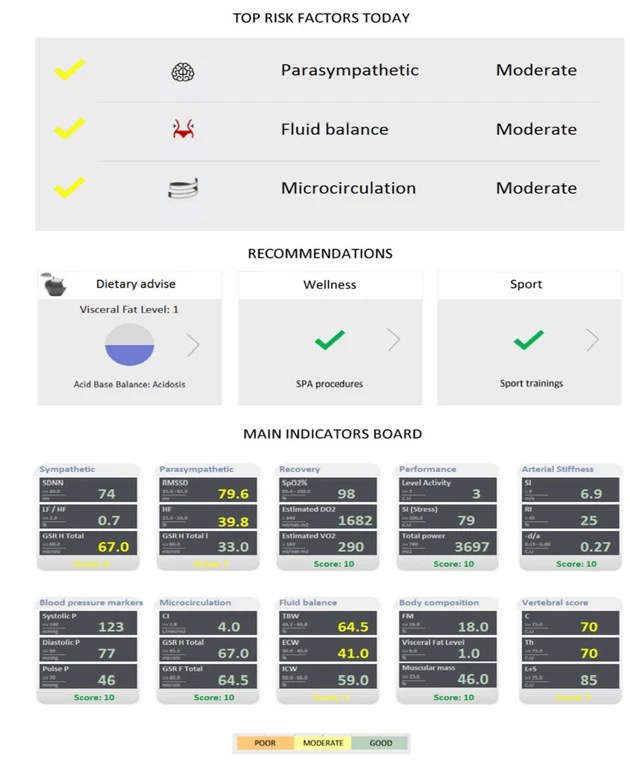Ai Doctor Wellness Score & Top Risk Factors

Ai Doctor gives the user a whole-body scan of their wellness and factors that are at risk. By adding all the data together, the wellness score is rated from 500 to 0. The poor range is 0 to 180, 180 to 365 is moderate, 365 to 420 is good, and 420 and above is excellent. As Ai Doctors, we recommend anyone under 250 should have a more comprehensive analysis with a licensed professional. Each section will have a score, like a grade in a classroom. Anything above 80 is where you ultimately want to be. 80 and below, there is an improvement that can happen. The Ai Doctor full-body health assessment is key for biohacking a person’s body.
For example, in this Ai Doctor scan, the person has an excellent body composition, but their ANS score is low. This means they are physically in good health, but sleep, stress, and fatigue affect their cognitive function. The same for microcirculation; this person is not circulating blood to critical organs as effectively as they could be. The vascular age shows the age of the heart. Let’s say this person is 30 years old. Their heart would be in excellent condition if their vascular age were 20. The score should be as close to the person’s age as possible in ideal conditions.
Ai Doctor wellness score also considers the amount of fat in a person’s body and ranks it as usual or not. Visceral fat is the fat around the abdominal organ in the body. If visceral fat is high, people must change their lifestyle to avoid chronic illnesses. Visceral fat can be increased because of diet, not exercising, or chronic substance use.

The Ai Doctor goes even further by listing the top risk factors affecting a person’s health. In this example, the person’s top three risk factors are parasympathetic, meaning their brain is not at its optimal state. This can be because of a person being unable to sleep at night, not balancing stress well because of work, personal issues, etc., and ultimately these two stressors cause tiredness (fatigue). Another risk factor is fluid balance, which may affect the person’s water intake. If a person consumes too much water, they have extra water outside the cells that can cause fluid retention. If a person is not drinking enough water, then the cells cannot transport nutrients to the organs in the body. The last risk factor, microcirculation, is a person’s lifestyle or disease. This person’s body cannot circulate the blood well enough to different parts of the body.
The Ai Doctor scan helps users create a personalized wellness plan that includes wellness and sports recommendations. Wellness practices can include yoga, sauna, and massages, to name a few. Each person is different and requires more wellness factors than others. The more wellness practices and recovery and incorporated into a person’s routine then their parasympathetic and sympathetic nervous system will see improvements. The sports recommendations will include specific types of measures such as walking, running, resistance training, and others.
The main indicators board will show the specific scores for each sub-section and give a rating from poor, moderate, and good. In this example the sympathetic.
Ultimately Ai Doctor users can use this information to form a care plan for their clients. They can ask questions about their lifestyle; how are they eating? Sleep? Pooing? De-stressing? Until the root cause is identified. With this in mind, Ai Doctor users can look at the recommendations for the client generated by the system. For example, this client’s recommendations for their diet are to balance acid-based food, participate in more spa procedures, and different types of sports. The wellness score and top risk factors provide a comprehensive overview of the person’s state of wellbeing.